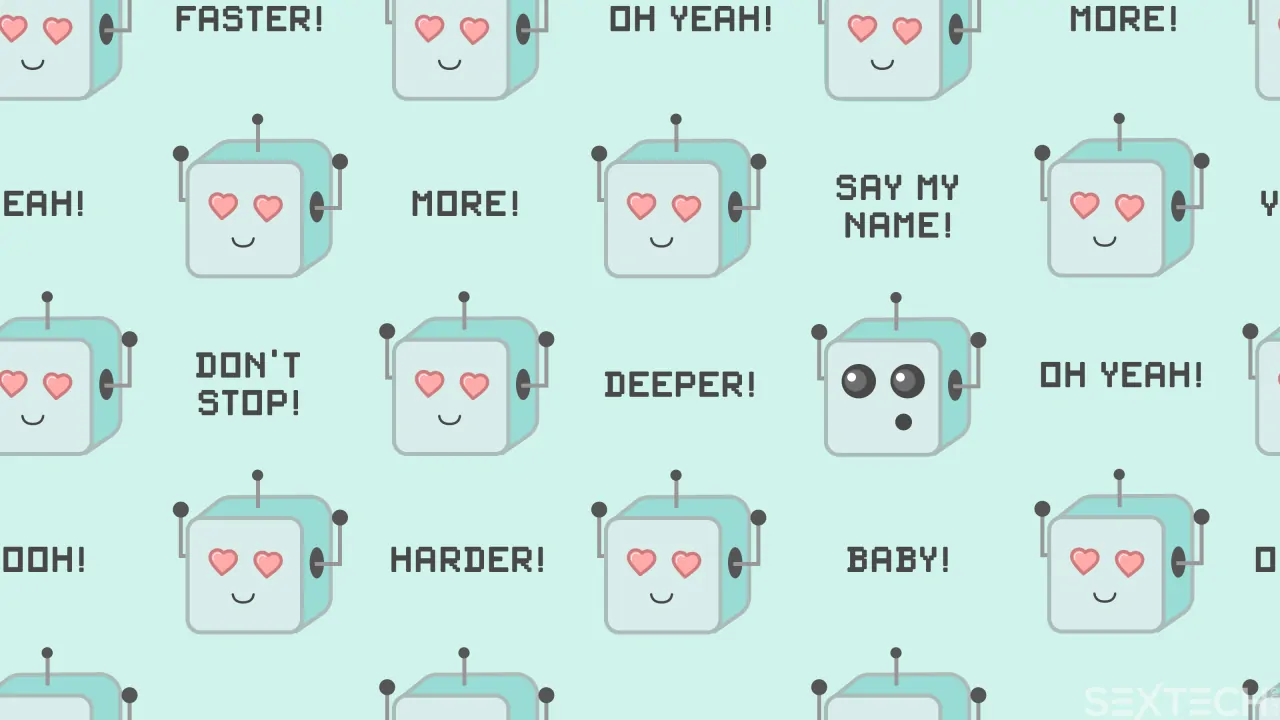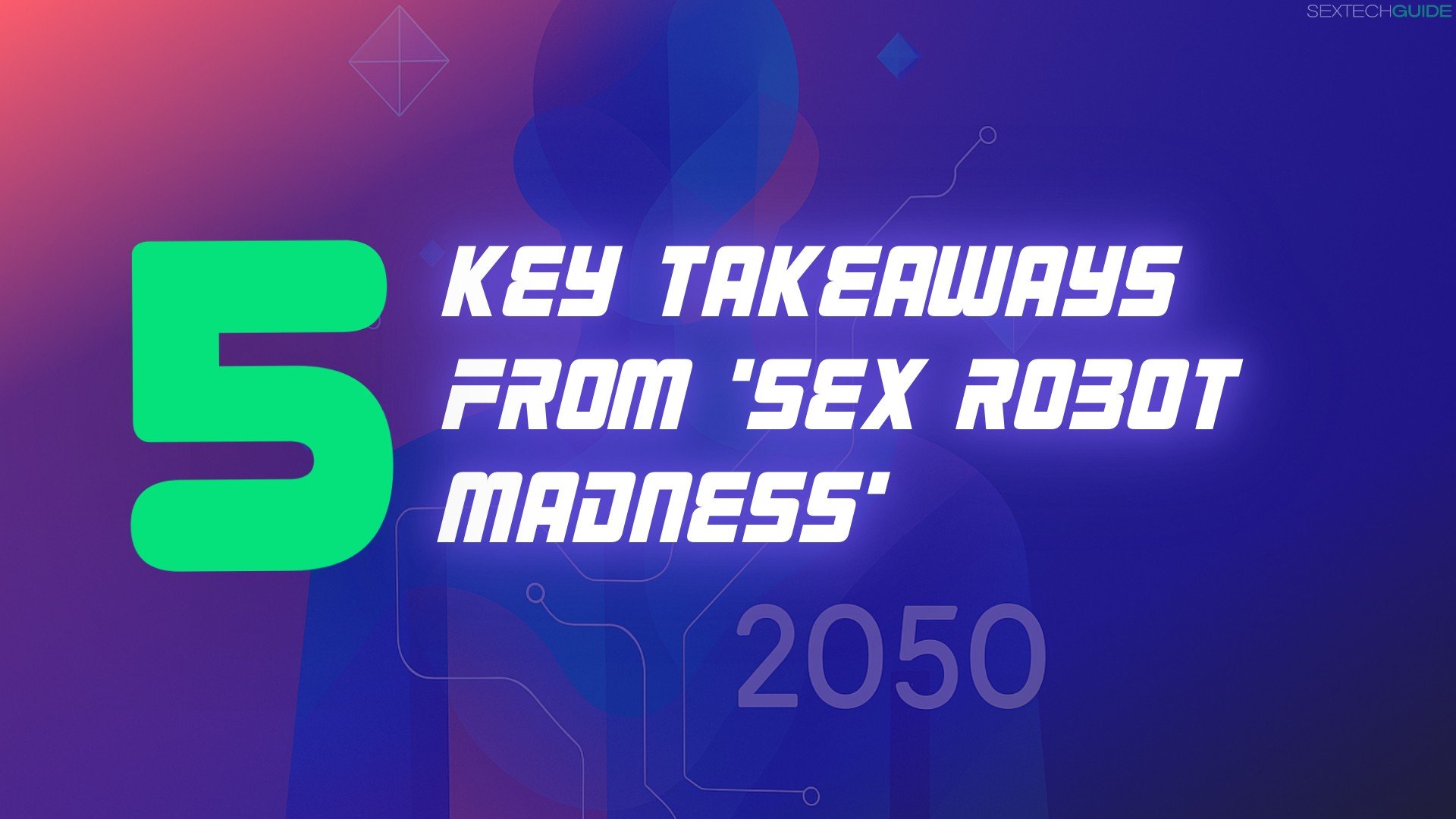Sex robots (or ‘sexbots’) have captured the imagination of people (largely men) in one form or another for decades, if not centuries.
With a recent surge of sensationalist news reports around sex robots, we thought SEXTECHGUIDE readers deserved some proper information – charting the myths, realities, controversies and questions you might have about sex robots.
If you’re reading this, chances are you want to find out more about the reality of sex robots. Once the stuff of sci-fi legend, the reality of a highly-developed robot lover is getting closer every day.
In 2016 Noel Sharkey, former advisor to the United Nations on robotics, said sex robots would be mainstream by 2026. That prediction doesn’t seem on track to play out, but in the years since debate about the ethics and legalities of sex robots has been heated. Should these innovations be celebrated as sophisticated tools for sexual pleasure, or do these lifelike qualities indicate the beginning of the end for human relationships?
From Japan’s specialist VR booths to companies attempting to launch robot brothels, the sex industry has often posed questions of technology that aren’t comfortable for people to accept.
What is a Sex Robot?
You could argue that something like a Fleshlight Launch is a type of ‘sex robot’. You could also argue that any vibrator could also be considered a sex robot. But for most people the term refers to a specific vision: a humanoid robot built exclusively for sex.
For some people artificial intelligence would also be a necessity, to make the experience as realistic as possible. Meanwhile, some DIY efforts (such as those in the 2010 documentary ‘My Sex Robot‘) simply aim to vaguely replicate the mechanics of sex: i.e. robotic thrusts. The end result isn’t going to get you anywhere close to the Uncanny Valley, though.
While some people might accept mechanical movement of sex dolls as a sex robot, many wouldn’t go along with that conceptual decoupling. There is a common view that a sex robot that can’t speak, react, flirt and otherwise act ‘human’ isn’t really a sexbot at all.
A Brief History of Sex Robots
While much current focus is on sex robots replicating humans, equipped with AI capable of conversations and fulfilling sexual needs, the use of ‘sex robots’ is arguably as historical as it is futuristic.
“The relationship between humans and their artificial counterparts runs right back to the myths of ancient Greece, where sculptor Pygmalion’s statue was brought to life with a kiss. It is the stuff of legend and of science fiction – part of our written history and a part of our imagined future.” Kate Devlin, Senior Lecturer in Social and Cultural Artificial Intelligence at King’s College, London.
Sex Robots in the Media: A Beginning

The most familiar form of the story comes from Ovid’s poem Metamorphoses, first published in 8 A.D., which depicts Pygmalion as a sculptor who carves an ivory woman that he then falls in love with and wishes into life. In a direct way, this story still informs the conversation around sex robots today, and brings up the same questions around ethics, appearance and sentience.
What is in no doubt is that this narrative is a male-driven one, aiming for a sex doll to replicate a human female rather than take on a more abstract form.
Sex Robots in 20th Century Media

The term ‘robot’ comes from the old Church Slavonic word ‘robota’, which means “servitude” or “forced labour”. It was first used to describe robots as we know them in the 1920s science fiction play R.U.R. (Rossum’s Universal Robots) by Czech playwright Josef Capek.
Though the robots in R.U.R. took on a typically masculine form, the fembot (or gynoid) trope followed soon after. In the 1927 silent film Metropolis the main female character literally becomes a robot. While she was not explicitly a built for sex, the idea of woman as robot has influenced much of the narrative up to today.

The swinging sixties saw fembots on the rise on US television screens. The TV sitcom My Living Doll (1964) had Rhoda Miller (AKA AF709) learning human emotions and behavior at the directions of her creator’s friend, Dr. Bob Miller.
The novel Do Androids Dream of Electric Sheep? (1967) by Philip K Dick, which the 1982 Ridley Scott film Blade Runner was based on, featured advanced robots of multiple genders, called replicants. The female replicants were exceptionally sexualized in both the book and the films. The replicant named Pris is known as a ‘basic pleasure model’, and femme fatale replicant Rachael is pursued (and forced upon) by protagonist Rick Deckard.

Satirical thriller The Stepford Wives (1972), was a novel made into a film in 1975 (and then again in 2014). It features eerily submissive women who turn out to be subservient fembots designed to replace the husbands’ wives.
Post-apocalyptic cyberpunk sci-fi film Cherry 2000 (1987) had the protagonist’s gynoid-wife malfunction during sex, which sent him on a quest for the perfect replacement bot, perpetuating the idea that women are merely objects that can be replaced.
Even comedies like Austin Powers: International Man of Mystery (1997) squeezed AI-equipped fembots into its plot.
21st Century Sex Robots in the Media

Films like AI: Artificial Intelligence (2001) included male and female sexbot prostitutes in the form of Jude Law’s Gigolo Joe and Ashley Scott’s Gigolo Jane.
Robot prostitutes and sexbot brothels, also predicted by David Levy in his 2007 book Love and Sex with Robots, do little to allay fears of mechanical lovers disrupting sex and relationships as we know them today.

Lars and the Real Girl (2007) sees a softer side of the narrative, that evokes empathy and understanding for “doll lovers”. We see Ryan Gosling’s character fall in love with his sex doll Bianca: a RealDoll, to be precise.
The movie brought a touching awareness to the therapeutic capabilities that dolls and robots can provide for people with social anxiety, or who find it difficult to form intimate relationships.

In 2013, Joaquin Phoenix starred as a lonely lead in the romantic sci-fi film Her, painting a picture of what sex could be like with a disembodied robot – imagine phone sex with Siri.
His character falls in love with his artificially intelligent iOS, seductively voiced by Scarlett Johansson. Eventually the operating systems surpass human intelligence and form connections with each other, leaving our protagonist (among many others) alone again.
Alex Garland’s 2014 film Ex Machina focused on the nature of consciousness and ethics, featuring a tech tycoon creating robots he cohabited and slept with in his remote luxury home/lab. Alicia Vikander played Ava: a robot with advanced AI that (spoiler alert) tricks a young man into falling in love with the robot, to aid its escape to freedom.

Humans is a British TV series (2015-2018) that explores the impact of introducing a perfect human replica in every home. The obligatory episode covering human/robot sex is also present. Through this we see the subsequent impact on human relationships, including both a father and son making advances on the robot.
The notion of consent is touched upon though not investigated in depth – the narrative perpetuates the notion of robots capable of sexual acts (ie. not explicitly made as sex robots) ultimately being considered ‘owned’, and objects of sexual gratification.

Perhaps a more acute image of the discussion around human interaction with robots came in HBO’s 2016 TV adaptation of the 1973 movie Westworld. Set in a wild, wild western amusement park with saloons and brothels, the writers of the modern adaptation were aware of the setting’s potentially problematic nature.
The series’ interactions between humans and robots are based on violence and control. This results in little more than a disdain for humanity itself.

In 2021 increased industry focus on the legalities of robots was reflected in Apple Studio’s announcement that Florence Pugh would play a killer sex robot in Dolly. The film, based on a 2011 Elizabeth Bear short story, sees the robot accused of homicide and demanding a lawyer.
What were the first sex robots like?
Recently there have been plenty of headlines about sex robots, but not a huge amount of actual robots for sale.
What started out as a hobbyist pursuit has grown into a fledgling industry, but one that still has big technical challenges to overcome.

Andy
In 2005, German aircraft mechanic Michael Harriman developed a sex doll called Andy. She was developed to have artificial breath so that during sex she panted, and her artificial heart beat faster.
Internal heaters raised her body temperature – apart from in the feet, which stayed cold. Via a remote control she could wiggle her hips. Though Andy’s time has passed, the sensory features she touted but fell short of are close to becoming reality in retail models.

Samantha
Spanish engineer Sergei Santos’, founder of Synthea Amatus, said his sex robot Samantha “needs to be romanced first”. Santos was reportedly working on the concept of Samantha for around 15 years before it began going on sale for $5,000 in 2017.
Similarly to Roxxxy (see below), she could switch between eight personalities, from ‘family mode’ to ‘sexy mode’, and had an SD card slot in her head, for updates.
Samantha, which looked far more plastic doll than human, garnered lots of mainstream media attention. The robot’s lowest point came at an Austrian electronics fair in 2017, where curious male fair-goers left a Samantha model “heavily soiled”. She had to be sent back to Spain for repairs and cleaning.

Roxxxy
Unveiled in 2010 by the TrueCompanion company, Roxxxy was touted as “the world’s first sex robot”. She couldn’t move but was wifi-enabled, and her AI gave her the ability to talk and have a simulated orgasm. She had several personality options, including ‘S&M Susan’, ‘Wild Wendy’, and ‘Mature Martha’ (who preferred to talk more than physically interact).
More controversial personas included ‘Young Yoko’ who was “very naive but curious and models an 18+ year old personality”, and ‘Frigid Farah’, who “does not always like to engage in intimate activities”. Though Douglas Hines, founder and president of the company, said that was never his intention, the “young” and “frigid” settings have received backlash over suggestions that they could encourage paedophilia or rape.
Such backlashes have been based on publicity around Roxxxy rather than people actually using her. Since unveiling the model in 2010 no journalist has reported Hines granting them access to the completed model, and there have been no public reports of sales.
Geminoid F: Influential non-sex robot

Designed by Japanese roboticist Hiroshi Ishiguro, Geminoid F was not a sex robot, but was an important indicator of robot realism capability when she first made waves around 2010. Later dubbed “the world’s sexiest robot” in the media, she depicted a 20-something Japanese woman.
Geminoid F could chat and sing, and while she was never depicted by her makers in a sexual way, her hyper-real looks set appearance standards for manufacturers across humanoid robot industries.
Best modern sex robots
RealDoll’s Harmony
RealDoll/Abys Creations’ first flagship product, Harmony went on sale in 2018 and became one of the most well-known robots on the market. It made headlines for being capable of conversation, movement and remembering what the user likes and dislikes.
Since then Abyss Creations has worked on sensors allowing the robot to respond to touch, internally heat and self-lubricate. Harmony is currently one of the most lifelike products on offer, and is paving the way for more prototypes of sex robots.
Owned by Matt McMullen, by early 2021 RealDoll, which was based in California then relocated to Las Vegas in 2021, was selling a large range of female sex robot models. Some come pre-configured and cost from around $6,000, while other models can be customized.
The Solana doll, first unveiled in 2018, had a peelable face. Some sex robot users have a fetish for the products’ technological elements, and may have sex with robots with the face half peeled off. These people are called technosexuals: a term that commonly refers to those who have sex with cars or other equipment.
New RealDoll sex robots come installed with an AI system called Realdollx, which allows the robots to move their heads, speak and form facial expressions. No other parts of RealDoll robots’ bodies are animatronic, but their limbs can be moved by the user. The dolls’ personalities and voice sounds are customizable.
The company has become a favorite of the tabloid press, with Britain’s Daily Star regularly featuring updates from a RealDoll advocate commenting under the name Brick Dollbanger.
“The physical act of sex will only be a small part of the time you spend with a sex robot – the majority of time will be spent socialising and interacting.” — Douglas Hines
WM Doll

When Chinese President Xi Jinping called for a “robot revolution” in the country in 2014, he may not have had sex robots on his mind. However, in 2016 WM DOLL, one of China’s most prominent sex doll companies, began fitting some models with basic AI.
The AI allowed the products to move their eyes, arms and torsos, and hold simple conversations. In 2018 the company told Reuters that it had only sold 20 of the AI-featuring dolls, compared to its total annual sales of 20,000 dolls.
“Of course we’re not expecting to make our AI dolls that human-like, after all we’re just making adult products,” said Liu Ding, WM Doll product manager. “But we will surely add more advanced technologies… for example making the limbs move more naturally.”
In 2020 WM Doll’s Danae model, which has blonde hair and arrived wearing an army outfit, became particularly popular. A retailer in Australia said the doll had become a big-seller due to more people being stuck at home due to pandemic lockdowns.
Shenzhen Atall Intelligent Robot Technology

Based in the southeast China province Guangdong, Shenzhen Atall Intelligent Robot Technology has probably generated more headlines about its controversies than its technological advancements.
In 2018, it was reported that the firm was exporting child-sized sex robots in the mould of both males and females, featuring AI systems. The robots’ eyes, lips and heads could move, and their developers said they could speak in both Chinese and English.
Around this time one of the company’s less controversial products was Emma: a sex robot whose temperature could be set to 37 degrees Celcius, to match that of a human. The company said it had also created custom-made sex robots for widowers, based on images of their late wives.
In 2021 the company focused on promoting FeiFei, its adult “intelligent robot girlfriend”. FeiFei is bilingual and has an external temperature control system.
Sex Robot FAQs
Sexbot controversies
Changing attitudes towards sex robots
Early modern sex robots were largely viewed by the public as little more than tools for sad lonely men who couldn’t find sex with real women.
Recent depictions of fictional sex robots such as HBO’s Westworld series have shown rich, successful people using them. Media companies such as Vice have covered sex robots extensively, not directly endorsing them but bringing them closer to youth culture and the mainstream.
Scientists have found that, somewhat predictably, attitudes towards sex robots tend to differ between men and women. In 2020 researchers in Norway found that after reading a story about a sophisticated sex robot, more men than women agreed with the statement: “I hope this type of robot is developed in the future.”
Women were more likely than men to agree with the statement: “I would like my partner to get rid of this robot.”
Mads Nordmo Arnestad, associate professor in social psychology and organizational behavior at BI Norwegian Business School and author of the study, said: “There’s plenty of research suggesting that some people feel threatened by and even jealous of their partners sex toy, but I don’t think anyone would say that using a vibrator counts as infidelity.”
He added: “But what if you could share a cigarette with that vibrator afterwards, and talk about your innermost feelings? And what if the artificially intelligent vibrator was attached to a full android body? At what point would people start intuiting that this is an act of infidelity?”
Will sex robots replace human sex and love?
Is sex with a robot ‘real’ sex? One could argue that it’s a form of masturbation, akin to using smart sex toys. Until sex robots gain technological skills comparable to those of humans, alongside perceived nuance, mysticism and unpredictability, it’s unlikely that they will eradicate human-to-human sex, remaining niche.
Author David Levy predicted that human-robot marriages will be commonplace by 2050. But can we really fall in love with non-human objects?
The opening of sex robot brothels suggested that sex robots might replace human sex workers before they replace human spouses or life partners. However, leading sexbot manufacturers say that consumers are demanding companionship.
A 2015 Japanese study found that on a neurological level, humans empathised with humanoid robots just as much as they did with humans. It suggested that our capacity for love goes beyond the human realm.
We might be able to fall in love with sex robots, but can that love be requited? Various scientists and academics assume that technology will reach the ability to create artificial sentience, which could be considered robot consciousness. A sexbot will one day probably be able to be programmed to fall in love with us: a “fake love”.
If humans are also ‘programmed’ to love by our biology, does that make our love fake? The question is not ‘can they, but ‘should’ robots be programmed to love us? Particularly if we fear robots replacing our relationships.
What about sex robots for therapy?
As noted in Lars and the Real Doll, on online forums iDollators (sex doll lovers) explain that sex dolls are used as “a therapeutic tool that helps them to overcome a traumatic breakup or to cope with seemingly inevitable social and sexual deprivation due to physical and/or mental impairment.”
Sexbots could potentially take this healing process to the next level. Consider the positive mental impact of PARO, the baby seal therapy robot. PARO has been found to reduce stress, improve relaxation and stimulate interaction.
In 2019 scientists in Austria ran a study to assess therapists’ attitudes towards sex robots. They found that 45 percent of therapists could imagine themselves recommending a sex robot for therapeutic use. Female therapists were less enthusiastic about sex robot use than male therapists.
“Moral, ethical, and treatment-related issues in this context are still unresolved and need to be further researched,” the researchers concluded.
Sex robot ethics
Should robots have rights?
In 2017, Sophia became the world’s first robot to be granted legal personhood with her Saudi Arabian citizenship: the country that only just gave women the right to drive. It was mostly a marketing ploy, but it made a statement on what human rights are worth in a world of inequality.
Would a robot programmed to obey be given the right to consent? When we look back at the core existence of robots as slaves, this is a contradiction, unless we accept robots into society as more than beings designed solely for our use.
When we look at sexbots that are programmed to say “no”, such as “Frigid Farah”, would her “no” eventually count in the eyes of the law as revoking consent when a person dismisses that?
With sex robots’ AI abilities far from a level at which they could be considered ‘conscious’, this debate won’t hit the sex robot industry for a long time.
Is the idea of a sex robot inherently sexist?
The founder of Campaign Against Sex Robots, Kathleen Richardson, claims that all female sex robots are inherently sexist and objectify women. Laura Bates pointed out in her New York Times opinion piece: “Their creators are selling far more than an inanimate sex aid. They are effectively reproducing real women, complete with everything… except autonomy.”
Almost all sex robots are currently built in the eyes of the hetero-patriarchal male gaze, commoditising the female form, but that is not to say they are inherently wrong. It’s not a given that banning them would do anything to alleviate sexism. Censorship has proven time and time again to hinder innovation that could overcome these issues.
Could sex robots encourage rape?
“The concern is that rape enacted on a doll could encourage rape in real life,” said Kate Devlin, an AI expert who specialises in love and sex with robots. “Legally, you can’t rape something that isn’t human, but ethically it has to be examined.”
There has been debate around sex robot models that simulate resistance, both in terms of them encouraging rape and being outlets for aggression not resulting in humans being harmed. Researchers have found parallels between men’s treatment of prostitutes and sex robots – treating both as “things” rather than people, raising more questions about blurred lines.
In 2017 philosophy professor Robert Sparrow wrote in the International Journal of Social Robotics: “Associating a fantasy of raping someone with sexual pleasure seems perilously close to a mechanism for Pavlovian conditioning for rape.
“At the very least, it might be expected to lower the barriers to rape by increasing the attractiveness of rape in the mind of the person who enjoys the fantasy.”
In 2021 Australian lawyer Maddie McCarthy called for sex robot legislation to be introduced in the country “sooner rather than later”, because sex robot technology has potential to “objectify and promote sexual violence against women.”
Could sex robots encourage paedophilia?
The creation and use of child sex robots has had plenty of media coverage, including news of men in Canada facing child porn charges for importing them.
People debate whether, like having sex with a ‘resisting’ robot, their use could prevent someone acting upon urges. Or could their use validate such urges?
Ron Arkin, a Georgia Institute of Technology robotics engineer, has argued that child-like sex dolls should be legal, and perhaps even prescribed as treatments, for potential abusers to redirect their desires from humans to machines.
In 2017 Chantal Cox-George and Susan Bewley, writing in the BMJ Sexual and Reproductive Health journal, wrote that, “While many sexbot users may distinguish between fact and fantasy, some buyers may not, leading to concern about potentially exacerbating the risk of sexual assault and rape of actual children and adults.”
More research is needed to better understand these issues. Discussing them in 2018, Arkin said: “We don’t know the answers yet. But recidivism in child sex offenders is a major problem in society that needs to be addressed, and there’s a possibility that technology may be able to help with that.”
Sex robot news
- Chinese humanoid robot has breasts so it can ‘be more intimate’ with humans
- The inside story of how a Chinese sex robot conference sparked an ‘authenticity’ battle
- ‘Women could be sex robot winners’: 5 key takeaways from the Sex Robot Madness documentary
- Realdoll moving to China, slashing prices, and launching $40/month AI subscription
- ‘Can a robot give that fuzzy feeling?’: Meeting Tenar, Ridmii’s AI sex bot

























